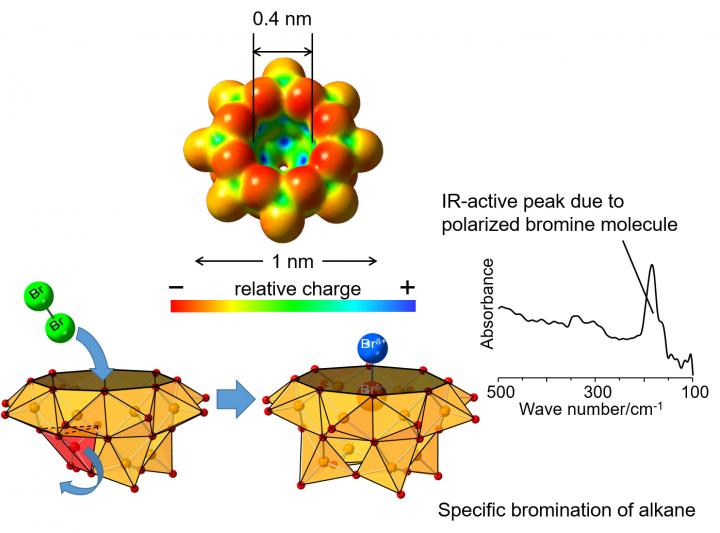
Credit: Kanazawa University
[Background]
Organocatalysts consisting of organic compounds without metal elements are receiving much attention as next generation catalysts in the hope of reducing environmental burden and coping with exhaustion/rising prices of rare metals. However, it is difficult for an organocatalyst to control radical reactions involving a single electron with high reactivity. Thus, reaction processes mediated by organocatalysts are rather limited. This hinders the development and application of organic synthesis by the use of organocatalysts.
N-heterocyclic carbene*1) is known as an organocatalyst free of metal elements and its catalytic reactions have been actively investigated. Studies on N-heterocyclic carbene as an organocatalyst started with the investigation of a biological reaction involving the coenzyme, thiamine (vitamin B1), a thiazolium*2) salt. The enol intermediate of the biological reaction is known to promote reactions of single electron transfer to electron acceptors such as lipoamide*3), flavin adenine dinucleotide (FAD) and Fe4S4*4), which play important roles in oxidation reactions. Scientists were inspired by this biological phenomenon and have synthesized N-heterocyclic carbene catalysts that could control radical reactions. These have been applied to organic synthesis. However, due to limits in the number of substrates that can be used for such a catalytic reaction, only a narrow range of organic compounds could be synthesized. This has severely limited applications, for example, in drug discovery.
[Results]
Prof. Ohmiya and co-workers designed an N-heterocyclic carbene catalyst in a rational and precise manner for the purpose of widening the range of target chemical substances for radical reactions. The group recently found a thiazolium-type N-heterocyclic carbene catalyst having an N-neopentyl group and applied this carbene catalyst to a radical reaction to synthesize a dialkyl ketone from an aliphatic aldehyde and an aliphatic carboxylic acid derivative (Figure 1). This was previously a very difficult synthesis. So far, a radical reaction using conventional N-heterocyclic carbene catalysts could be applied only to aromatic aldehydes as catalytic reaction substrates. The N-heterocyclic carbene catalyst newly developed here is a versatile catalyst applicable to both aromatic and aliphatic aldehydes, thus significantly widening the application of radical reactions of organocatalysts.
The key to this success was their finding that the N-neopentyl group of the thiazolium-type N-heterocyclic carbene was effective in the reaction progress, while their study was carried out making full use of organic chemistry and measurement techniques. The bulkiness of the N-neopentyl group was found to be effective not only in promoting a coupling reaction of two different radical species generated in the reaction system but also in suppressing undesirable side reactions.
The present catalytic reaction has the following merits in organic chemical synthesis; 1) bulky molecules can be reaction substrates due to involvement of a highly reactive radical, and 2) the method is excellent in terms of a wide range of functional groups and substrates, since the catalytic reaction can be carried out under mild conditions without the need for metal catalysts or redox reagents. Thus, it is now possible to synthesize more than 35 bulky and complex dialkyl ketone, which was previously very difficult. This enables the synthesis of natural compounds and pharmaceuticals having a dialkyl ketone backbone from an aliphatic aldehyde and an aliphatic carboxylic acid derivative.
[Future prospects]
In this study, the research group has designed a new organocatalyst that controls radical reactions, which significantly widens the applicability to various substrates. The study is expected to accelerate drug discovery, since it enables synthesis of organic compounds with high added value that used to be nearly impossible to attain. From an academic viewpoint, the study has established design guidelines of organocatalysts that can control radical reactions.
###
[Glossary]
*1) Carbene
A carbene is a divalent molecular species containing a neutral carbon with six valence electrons.
*2) Thiazolium
Thiazole, or 1,3-thiazole, is an aromatic five-membered heterocyclic compound that contains both sulfur and nitrogen. Alkylation at N atom forms a thiazolium cation. Many derivatives of thiazole and thiazolium salt are known with various chemical groups introduced to a member(s) of the heterocyclic ring.
*3) Lipoamide
Lipoamide is a trivial name for 6,8-dithiooctanoic amide. It is not naturally occurring.
*4) Fe4S4
Also called 4Fe-4S cluster. This cubane-type cluster is found in some ferredoxins and aconitase and plays an essential role in their redox reactions.
Media Contact
Ayako Honda
[email protected]
Original Source
https:/
Related Journal Article
http://dx.




